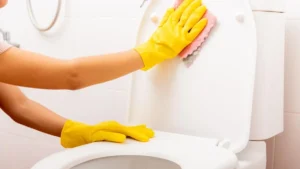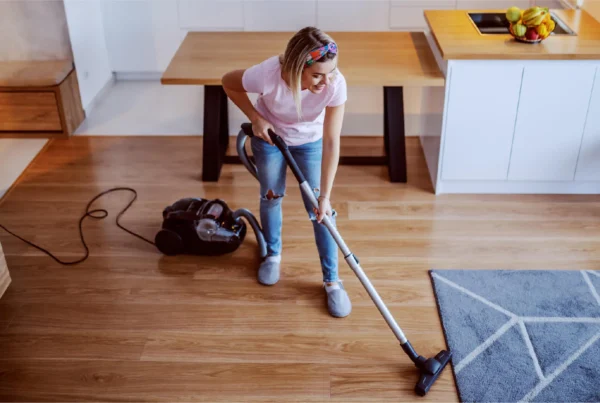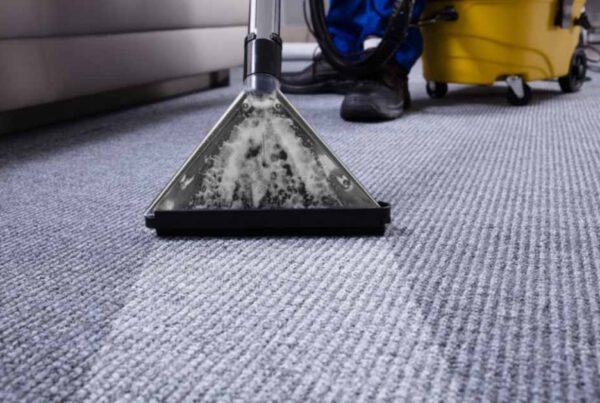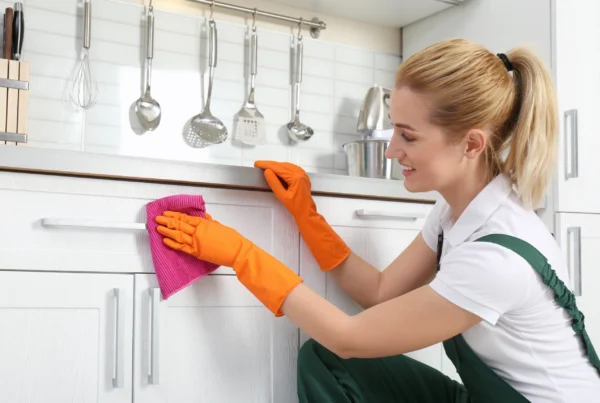How Often Should Bathrooms Be Cleaned? Daily, Weekly, or Monthly?
If there’s one space in the home that sees constant use and quickly gets dirty, it’s the bathroom. Between showers, sinks, and toilets, moisture and bacteria build up fast, and that’s before considering the grime from daily routines. So, how often should bathrooms be cleaned?
Experts agree that bathrooms should be cleaned at least once a week, with certain tasks like wiping sinks and disinfecting toilets done more frequently. However, the ideal cleaning schedule can vary depending on how many people live in your home, how often the bathroom is used, and the local humidity level.
In this guide, we’ll break down the ideal bathroom cleaning frequency, explain why it matters, and share a practical step-by-step routine for keeping your space spotless, sanitary, and fresh all week long.
Why Bathroom Cleaning Frequency Matters
 The bathroom is a magnet for bacteria, mold, and unpleasant odors due to constant moisture and humidity. Without regular cleaning, germs can multiply on surfaces like toilet handles, faucets, and doorknobs within hours. Mold spores also thrive in damp corners, leading to mildew stains, bad smells, and potential health issues.
The bathroom is a magnet for bacteria, mold, and unpleasant odors due to constant moisture and humidity. Without regular cleaning, germs can multiply on surfaces like toilet handles, faucets, and doorknobs within hours. Mold spores also thrive in damp corners, leading to mildew stains, bad smells, and potential health issues.
Keeping up with a cleaning schedule isn’t just about appearance; it’s about hygiene and well-being. Regular cleaning:
- Prevents illness by removing bacteria and viruses that spread through touch.
- Extends the life of your fixtures, tiles, and grout.
- Reduces hard water and soap scum buildup, which becomes difficult to remove if left unchecked.
- Improves air quality and eliminates musty odors.
A clean bathroom simply feels better, fresh towels smell nicer, mirrors sparkle, and the whole room feels more relaxing.
How Often Should You Clean Different Parts of the Bathroom?
Not every surface needs the same attention. Some areas require daily touch-ups, while others can wait for a weekly or monthly deep clean. Let’s break it down.
Daily Bathroom Cleaning Tasks
Even if you can’t commit to a full scrub every day, a few quick daily tasks can make a huge difference. These simple habits prevent dirt and grime from building up and keep your bathroom looking tidy between deeper cleans.
Focus on:
- Wiping down surfaces: After brushing your teeth or washing your hands, use a microfiber cloth or disinfectant wipe on the sink, faucet, and countertop. This prevents toothpaste and soap residue from hardening.
- Drying the shower and tub: Wipe shower doors or tiles after each use to stop soap scum and mildew. A squeegee is great for this job.
- Flushing and cleaning the toilet bowl: Give it a quick brush if needed, especially in shared bathrooms.
- Emptying the trash can: Prevents odors and bacteria from lingering.
- Hanging up towels properly: Helps them dry faster and prevents a mildew smell.
Spending just five minutes on these small tasks each day will drastically reduce the need for intense scrubbing later.
Weekly Bathroom Cleaning Tasks
A weekly deep clean keeps germs in check and ensures your bathroom remains fresh and hygienic. This is where you tackle the details, scrubbing, disinfecting, and polishing every major surface.
Here’s what to do once a week:
- Scrub the toilet thoroughly inside and out, including the base and behind the seat.
- Clean the sink and faucet, removing toothpaste buildup and water stains.
- Wipe mirrors using glass cleaner or a vinegar-water solution.
- Disinfect counters, doorknobs, and handles, which harbor germs from daily contact.
- Scrub the shower or bathtub, focusing on grout, tiles, and drain areas.
- Mop the floors with a disinfectant cleaner to remove dust and bacteria.
- Replace or wash bath mats and towels to keep them smelling clean and germ-free.
For most households, doing this once a week keeps everything manageable and prevents grime from turning into a bigger project.
Monthly Bathroom Cleaning Tasks
Some cleaning jobs don’t need weekly attention but still require regular upkeep to maintain hygiene and prevent damage.
Every month:
- Wash the shower curtain or liner to prevent mildew.
- Clean out the bathroom fan or vent dust buildup can affect air circulation and encourage mold.
- Wipe down light fixtures and baseboards to remove dust.
- Declutter cabinets and drawers, tossing expired toiletries or empty bottles.
- Polish faucets and hardware to prevent corrosion and keep them looking new.
Setting a reminder once a month ensures these often-forgotten areas stay clean and functional.
Seasonal or Deep Cleaning Tasks
A few times a year, it’s worth giving your bathroom an even deeper clean to reset it completely. This helps address buildup in hidden areas and keeps your space healthy long-term.
During a seasonal clean, focus on:
- Scrubbing grout with a specialized cleaner or steam cleaner.
- Descaling showerheads and faucets using vinegar to remove mineral buildup.
- Cleaning behind and under the toilet and sink areas that collect dust and bacteria.
- Washing walls or tiles to remove unseen residue.
- Organizing storage areas for better accessibility.
Doing this every 3–4 months helps maintain a spotless bathroom year-round and prevents major cleaning marathons later.
How Often to Clean Depending on Household Type
Cleaning frequency also depends on who’s using the bathroom and how often it’s in use.
- Single-person households: Once a week for major cleaning is usually enough.
- Families or shared homes: Clean twice a week or more, since multiple people bring in more germs and dirt.
- Guest bathrooms: A quick wipe weekly and a deeper clean before guests arrive is ideal.
- Children’s bathrooms: More frequent cleaning (every few days) helps maintain hygiene and reduce clutter.
If your bathroom is small or poorly ventilated, increase cleaning frequency to prevent moisture buildup and mold.
Signs Your Bathroom Needs Cleaning More Often
Even if you have a schedule, your bathroom might show signs it needs extra attention. Look out for:
- Lingering odors even after cleaning
- Visible mold or mildew spots on tiles or grout
- Soap scum that won’t rinse away
- Cloudy mirrors or streaky glass
- Slippery floors or water spots
If you notice any of these, it’s time to adjust your routine, especially during humid months when mold spreads faster.
The Best Order to Clean Your Bathroom
 Having a system makes cleaning quicker and more efficient. Here’s the most effective order to follow during your weekly cleaning:
Having a system makes cleaning quicker and more efficient. Here’s the most effective order to follow during your weekly cleaning:
- Start from the top: Dust vents, light fixtures, and shelves so debris falls downward.
- Move to mirrors and counters: Clean these before wet areas.
- Tackle the toilet: Scrub inside the bowl, then sanitize the exterior.
- Clean the shower or tub: Use bathroom cleaner or a mix of baking soda and vinegar for tough stains.
- Finish with the floor: Sweep first, then mop with disinfectant.
Working from top to bottom ensures you’re not spreading dirt back onto cleaned surfaces.
Tips for Keeping Bathrooms Clean Between Deep Cleans
Maintaining cleanliness throughout the week prevents your bathroom from becoming overwhelming to clean later. Here’s how:
- Keep disinfecting wipes handy for quick touch-ups.
- Use a daily shower spray or squeegee to prevent buildup.
- Run the exhaust fan after showers to reduce humidity and prevent mold.
- Store items neatly in baskets or containers to minimize clutter.
- Place a small trash can with a lid to contain odors and make emptying easy.
Small habits make a big difference with these daily steps; your weekly cleaning will take half the time.
Common Mistakes People Make When Cleaning Bathrooms
Even frequent cleaning can miss the mark if done incorrectly. Some common mistakes include:
- Using too much cleaner: More product doesn’t mean a deeper clean. Overuse can leave sticky residue that attracts dirt.
- Ignoring grout and behind fixtures: These hidden spots are mold magnets.
- Not letting disinfectants sit long enough: Most need a few minutes to kill bacteria effectively.
- Using the same cloth for all surfaces: This spreads germs instead of removing them. Always switch clothes for toilets and sinks.
By cleaning smarter, not harder, you’ll save time and effort while keeping your bathroom more sanitary.
Can You Overclean a Bathroom?
Technically, yes, using too many harsh chemicals or cleaning too frequently can wear down finishes, grout, and metal fixtures. The key is balance: focus on daily maintenance and weekly disinfecting while avoiding abrasive scrubbing unless necessary.
If you prefer an eco-friendly approach, use natural cleaning agents like vinegar, baking soda, and lemon juice. They’re gentle yet effective for routine cleaning and safe for most surfaces.
How Long Should a Typical Bathroom Cleaning Take?
The time required depends on the level of cleaning:
- Daily touch-ups: 5–10 minutes
- Weekly clean: 30–45 minutes
- Monthly or deep clean: 1–2 hours
Breaking tasks into smaller routines can help you stay consistent without feeling overwhelmed.
When to Hire Professional Bathroom Cleaners
If you’re too busy, have a large home, or just want a more thorough clean, hiring professionals is a great option. Professional cleaners use advanced tools like steamers and disinfecting solutions to remove mold, kill germs, and reach hard-to-clean areas efficiently.
They’re especially helpful for move-in or move-out cleaning, post-renovation cleaning, or maintaining commercial bathrooms.
Final Thoughts
So, how often should bathrooms be cleaned? Ideally, you should clean your bathroom lightly every day, deeply every week, and thoroughly every month. This approach prevents grime, keeps mold away, and ensures your bathroom always feels fresh and inviting.
Whether you do it yourself or hire experts, maintaining a regular cleaning schedule is key to a healthier, happier home.
If you’d rather skip the hassle and let the professionals handle it, ProClean’s House Cleaning Services Abbotsford has you covered. Our expert cleaners specialize in thorough, eco-friendly bathroom cleaning that leaves your space sparkling and sanitized.
Book your bathroom cleaning today and enjoy a spotless home without the stress, because a clean bathroom is a happy bathroom.
Follow us on our socials here:
Find out more articles that can help you below:
- How to Clean Bathroom Floor
- Keeping Your Bathroom Sink Drain Clean: Simple Hacks
- What Do Maids Use to Clean Bathrooms





